Exploring the Spatial Relative Risk of COVID-19 in Berlin-Neukölln
Abstract
:1. Introduction
2. Materials and Methods
2.1. Study Area
2.1.1. Population
2.1.2. Built Structures
2.1.3. The Socio-Economic Situation
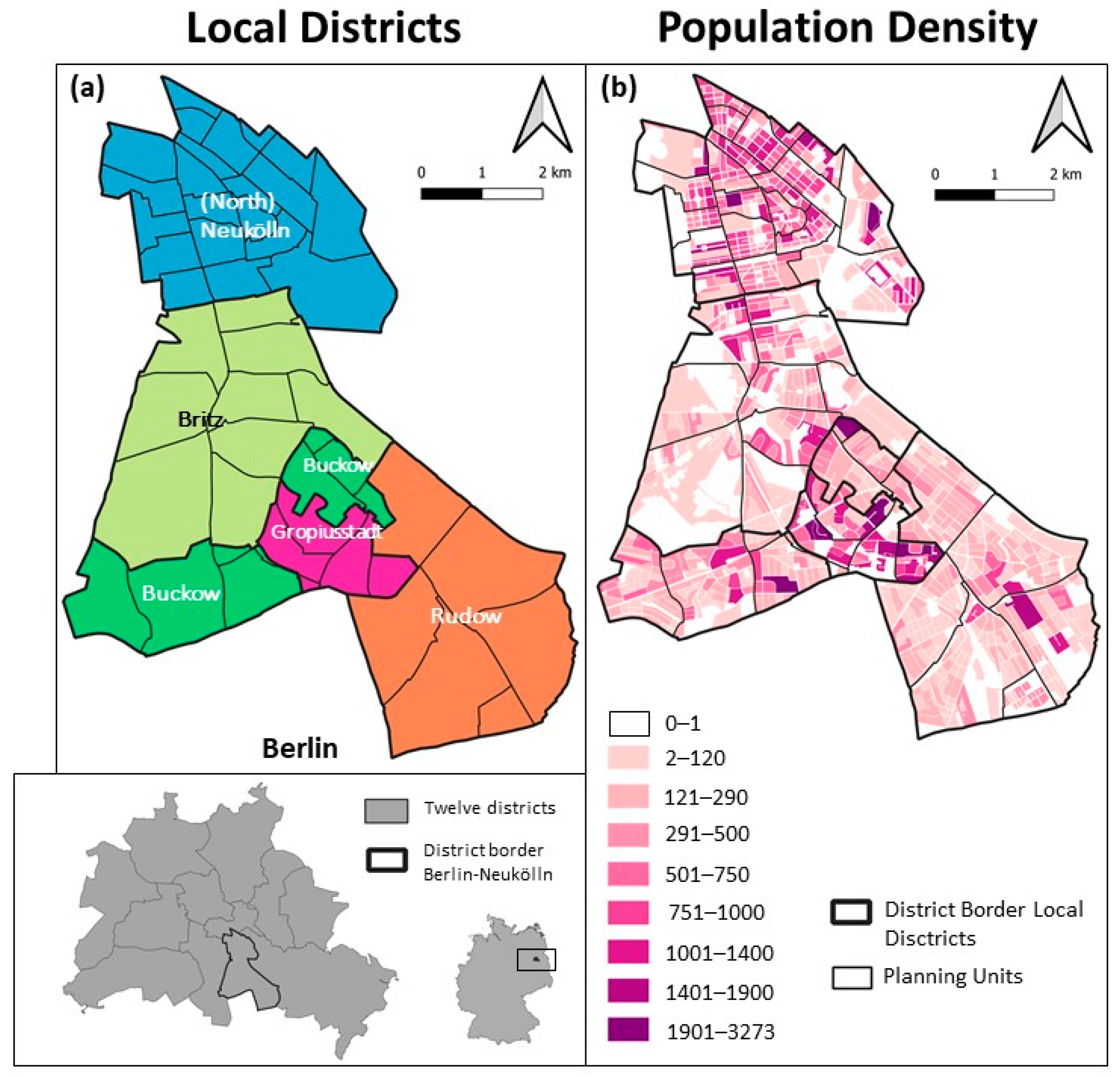
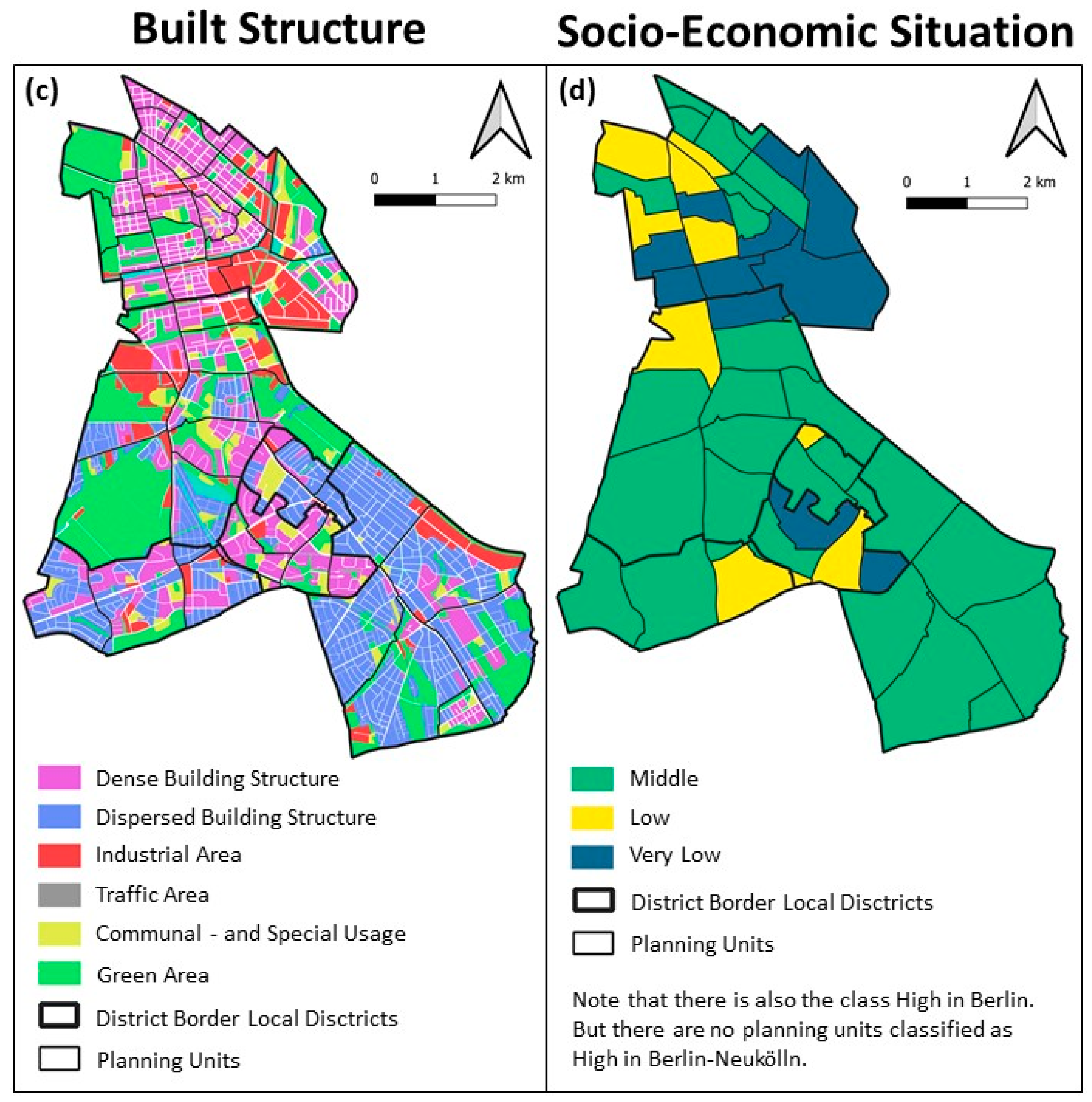
2.2. Data
2.2.1. COVID-19 Case Data
2.2.2. Control Data
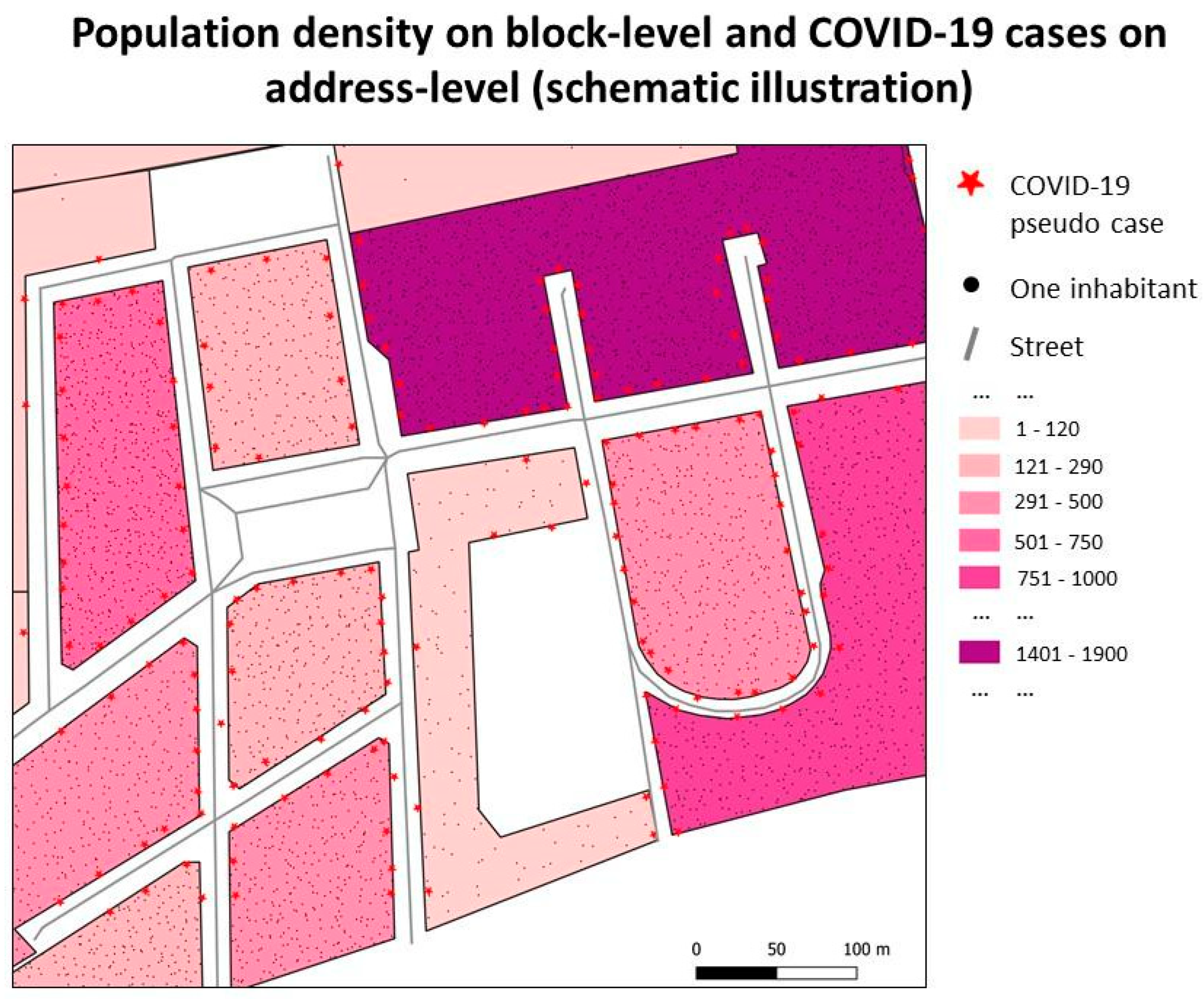
2.3. Methods
2.3.1. The Spatial Relative Risk Function
2.3.2. Kernel Density Estimation
2.4. Calculating the Spatial Relative Risk Surface
3. Results

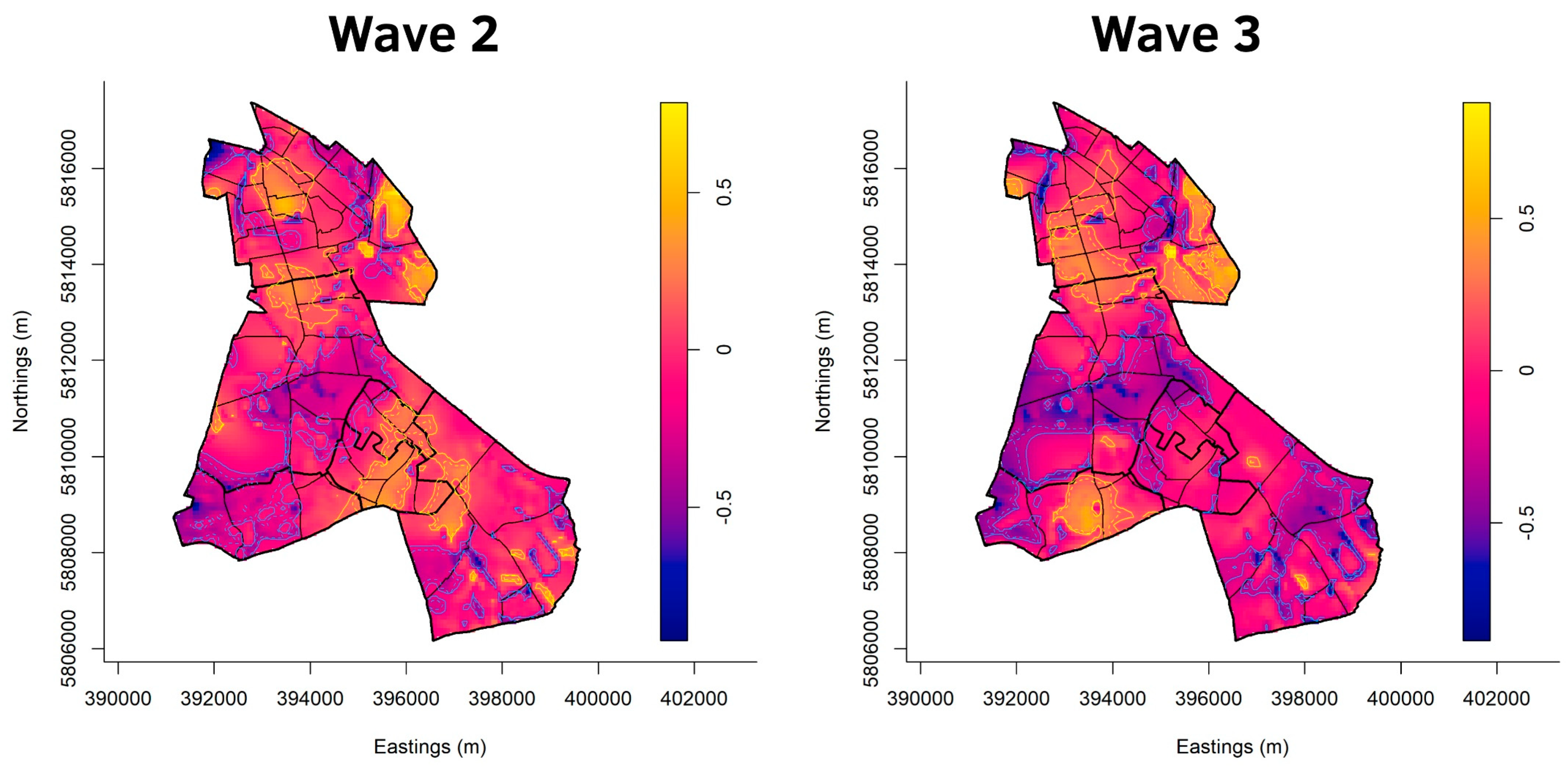
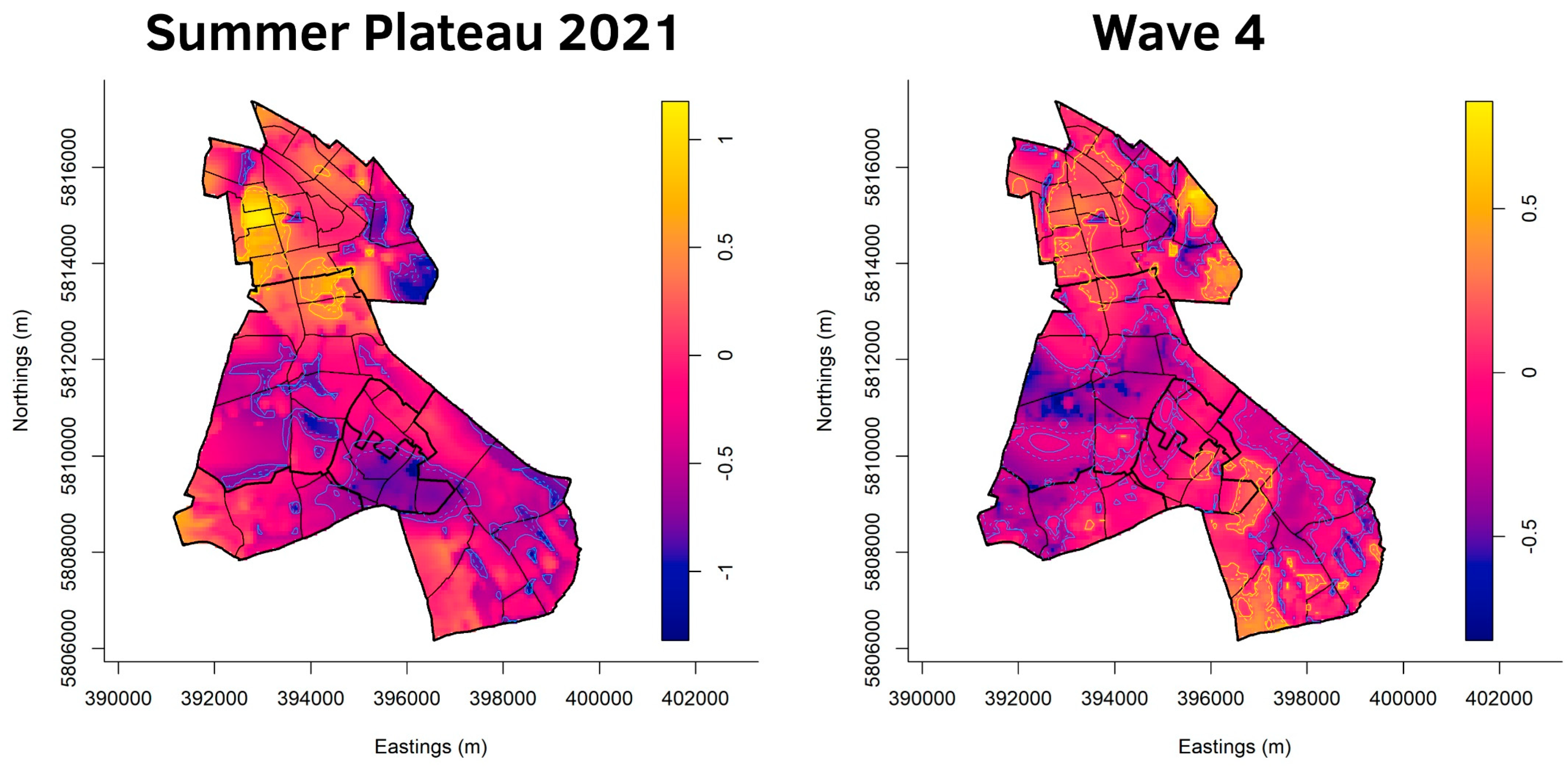
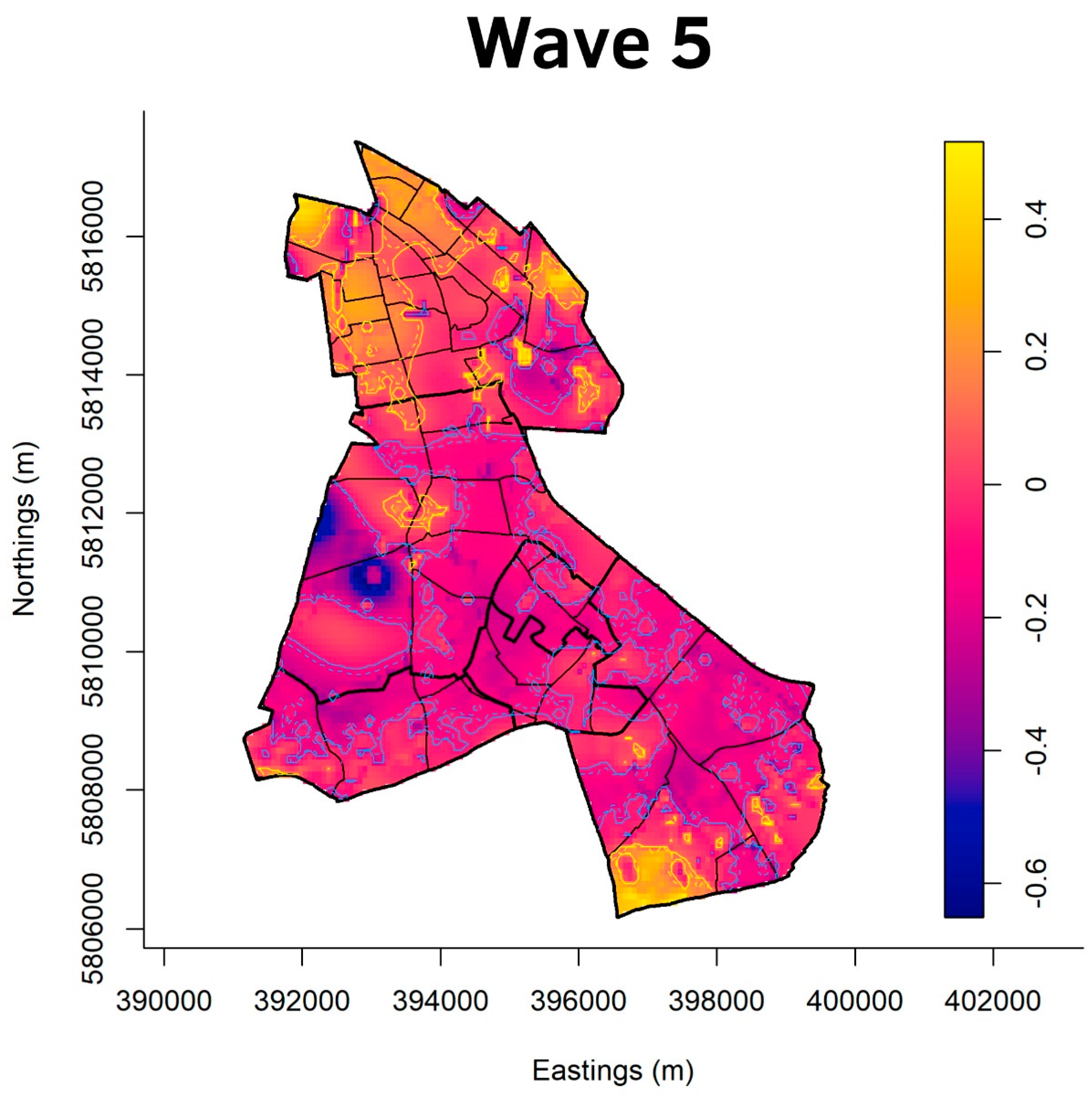
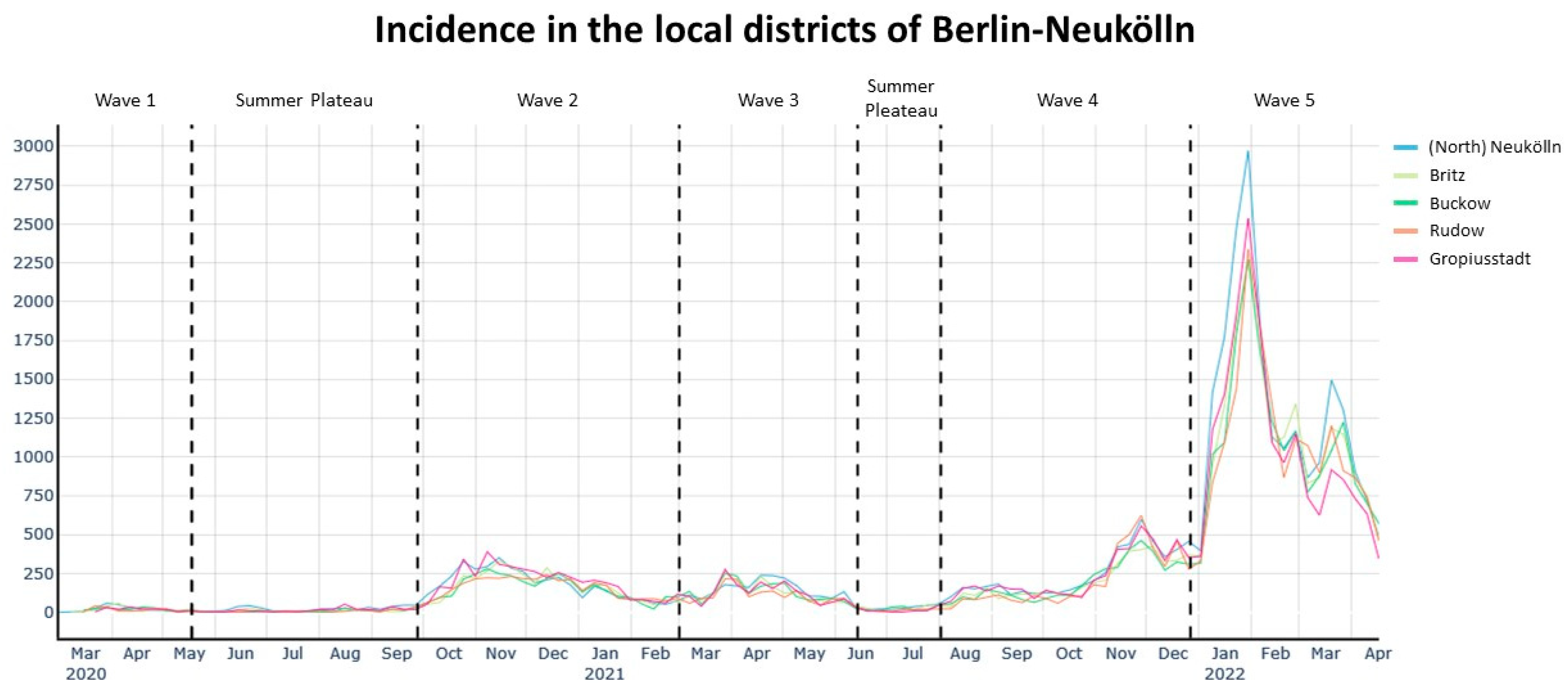
4. Discussion
4.1. Socio-Economic Situation
4.2. Built Structures
4.3. Limitations
5. Conclusions
Author Contributions
Funding
Institutional Review Board Statement
Informed Consent Statement
Data Availability Statement
Acknowledgments
Conflicts of Interest
References
- WHO. WHO Director-General’s Opening Remarks at the Media Briefing on COVID-19. 2020. Available online: https://www.who.int/director-general/speeches/detail/who-director-general-s-opening-remarks-at-the-media-briefing-on-covid-19---11-march-2020 (accessed on 11 March 2020).
- RKI. Epidemiologisches 2022 Bulletin—Aktualisierte Phaseneinteilung der COVID-19-Pandemie (10/2022). 2022. Available online: https://www.rki.de/DE/Content/Infekt/EpidBull/Archiv/2022/Ausgaben/10_22.pdf?__blob=publicationFile (accessed on 21 March 2022).
- Franch-Pardo, I.; Napoletano, B.M.; Rosete-Verges, F.; Billa, L. Spatial analysis and GIS in the study of COVID-19. A review. Sci. Total Environ. 2020, 739, 140033. [Google Scholar] [CrossRef] [PubMed]
- Rezaei, M.; Nouri, A.A.; Park, G.S.; Kim, D.H. Application of Geographic Information System in Monitoring and Detecting the COVID-19 Outbreak. Iran. J. Public Health 2020, 49 (Suppl. 1), 114–116. [Google Scholar] [CrossRef] [PubMed]
- Rossman, H.; Keshet, A.; Shilo, S.; Gavrieli, A.; Bauman, T.; Cohen, O.; Shelly, E.; Balicer, R.; Geiger, B.; Dor, Y.; et al. A framework for identifying regional outbreak and spread of COVID-19 from one-minute population-wide surveys. Nat. Med. 2020, 26, 634–638. [Google Scholar] [CrossRef]
- Arab-Mazar, Z.; Sah, R.; Rabaan, A.A.; Dhama, K.; Rodriguez-Morales, A.J. Mapping the incidence of the COVID-19 hotspot in Iran—Implications for Travellers. Travel Med. Infect. Dis. 2020, 34, 101630. [Google Scholar] [CrossRef]
- Basnet, B.B.; Pant, R.R.; Bishwakarma, K.; Paudel, S.; Pandey, N.; Adhikari, S.K.; Ranabhat, K.; Ghimire, A. A Year Trend Analysis and Spatial Distribution of COVID-19 Cases in Nepal. Asia Pac. J. Public Health 2021, 33, 641–644. [Google Scholar] [CrossRef]
- Guan, W.J.; Ni, Z.Y.; Hu, Y.; Liang, W.H.; Qu, C.Q.; He, J.X.; Liu, L.; Shan, H.; Lei, C.L.; Hui, D.S.C.; et al. Clinical Characteristics of coronavirus disease 2019 in China. N. Engl. J. Med. 2020, 382, 1708–1720. [Google Scholar] [CrossRef]
- Martellucci, C.A.; Sah, R.; Rabaan, A.A.; Dhama, K.; Casalone, C.; Arteaga-Livias, K.; Sawano, T.; Ozaki, A.; Bhandari, D.; Higuchi, A.; et al. Changes in the spatial distribution of COVID-19 incidence in Italy using GIS-based maps. Ann. Clin. Microbiol. Antimicrob. 2020, 19, 30. [Google Scholar] [CrossRef] [PubMed]
- Dong, E.; Du, H.; Gardner, L. An interactive web-based dashboard to track COVID-19 in real time. Lancet Infect. Dis. 2020, 20, 533–534. [Google Scholar] [CrossRef] [PubMed]
- Yalcin, M. Mapping the global spatio-temporal dynamics of COVID-19 outbreak using cartograms during the first 150 days of the pandemic. Geocarto Int. 2020, 37, 3791–3800. [Google Scholar] [CrossRef]
- RKI. COVID-19: Fallzahlen Deutschland und Weltweit. 2022. Available online: https://www.rki.de/DE/Content/InfAZ/N/Neuartiges_Coronavirus/Fallzahlen.htm (accessed on 20 June 2022).
- Byass, P. Eco-epidemiological assessment of the COVID-19 epidemic in China, January–February 2020. Glob. Health Action 2020, 13, 1760490. [Google Scholar] [CrossRef]
- Openshow, S. A million or so correlation coefficients, three experiments on the modifiable areal unit problem. In Statistical Applications in the Spatial Science; Pion: Lodnon, England, 1979; pp. 127–144. [Google Scholar]
- Garcia-Morata, M.; Gonzalez-Rubio, J.; Segura, T.; Najera, A. Spatial analysis of COVID-19 hospitalised cases in an entire city: The risk of studying only lattice data. Sci. Total. Environ. 2022, 806, 150521. [Google Scholar] [CrossRef]
- Diggle, P.J. Statistical Analysis of Spatial and Spatio-Temporal Point Patterns; CRC Press: Boca Raton, FL, USA, 2013. [Google Scholar]
- Grekousis, G. Spatial Analysis Methods and Practice: Describe—Explore—Explain through GIS. In Spatial Analysis Methods and Practice; Cambridge University Press: Cambridge, UK, 2020; pp. 147–206. [Google Scholar]
- Brown, P.; Hirschfield, A.; Marsden, J. Analysing Spatial Patterns of Disease: Some Issues in the Mapping of Incidence Data for Relatively Rare Conditions. In The Added Value of Geographical Information Systems in Public and Environmental Health the GeoJournal Library; De Lepper, M.J.C., Scholten, H.J., Stern, R.M., Eds.; Springer: Dordrecht, The Netherlands, 1995; Volume 24. [Google Scholar]
- Nakaya, T. An Information Statistical Approach to the Modifiable Areal Unit Problem in Incidence Rate Maps. Environ. Plan. A Econ. Space 2000, 32, 91–109. [Google Scholar] [CrossRef]
- Theophilides, C.N.; Ahearn, S.C.; Grady, S.; Merlino, M. Identifying West Nile virus risk areas: The Dynamic Continuous-Area Space-Time system. Am. J. Epidemiol. 2003, 157, 843–854. [Google Scholar] [CrossRef]
- Flowerdew, R.; Manley, D.J.; Sabel, C.E. Neighbourhood effects on health: Does it matter where you draw the boundaries? Soc. Sci. Med. 2008, 66, 1241–1255. [Google Scholar] [CrossRef]
- Auchincloss, A.H.; Gebreab, S.Y.; Mair, C.; Diez Roux, A.V. A review of spatial methods in epidemiology, 2000-2010. Annu. Rev. Public Health 2012, 33, 107–122. [Google Scholar] [CrossRef]
- Araujo Navas, A.L.; Osei, F.; Soares Magalhães, R.J.; Leonardo, L.R.; Stein, A. Modelling the impact of MAUP on environmental drivers for Schistosoma japonicum prevalence. Parasites Vectors 2020, 13, 112. [Google Scholar] [CrossRef] [PubMed]
- Feitosa, N.M.; da Costa Rodrigues, B.; Petry, A.C.; Nocchi, K.J.C.V.; de Moraes Brindeiro, R.; Zilberberg, C.; Nunes-da-Fonseca, R. Molecular testing and analysis of disease spreading during the emergence of COVID-19 in Macaé, the Brazilian National Capital of Oil. Sci. Rep. 2021, 11, 20121. [Google Scholar] [CrossRef]
- Sarwar, S.; Waheed, R.; Sarwar, S.; Khan, A. COVID-19 challenges to Pakistan: Is GIS analysis useful to draw solutions? Sci. Total Environ. 2020, 730, 139089. [Google Scholar] [CrossRef] [PubMed]
- Elson, R.; Davies, T.M.; Lake, I.R.; Vivancos, R.; Blomquist, P.B.; Charlett, A.; Dabrera, G. The spatio-temporal distribution of COVID-19 infection in England between January and June 2020. Epidemiol. Infect. 2021, 149, e73. [Google Scholar] [CrossRef]
- MohammadEbrahimi, S.; Mohammadi, A.; Bergquist, R.; Dolatkhah, F.; Olia, M.; Tavakolian, A.; Pishgar, E.; Kiani, B. Epidemiological characteristics and initial spatiotemporal visualisation of COVID-19 in a major city in the Middle East. BMC Public Health 2021, 21, 1373. [Google Scholar] [CrossRef] [PubMed]
- Xu, M.; Cao, C.; Zhang, X.; Lin, H.; Yao, Z.; Zhong, S.; Huang, Z.; Duerler, R.S. Fine-Scale Space-Time Cluster Detection of COVID-19 in Mainland China Using Retrospective Analysis. Int. J. Environ. Res. Public Health 2021, 18, 3583. [Google Scholar] [CrossRef] [PubMed]
- Helbich, M.; Browning, M.H.M.; Kwan, M.-P. Time to address the spatiotemporal uncertainties in COVID-19 research: Concerns and challenges. Sci. Total. Environ. 2020, 764, 142866. [Google Scholar] [CrossRef]
- Wang, Y.; Di, Q. Modifiable areal unit problem and environmental factors of COVID-19 outbreak. Sci. Total. Environ. 2020, 740, 139984. [Google Scholar] [CrossRef] [PubMed]
- Soederberg, S. Governing stigmatised space: The case of the ‘slums’ of Berlin-Neukölln. New Polit. Econ. 2017, 22, 478–495. [Google Scholar] [CrossRef]
- Holm, A. Gentrification in Berlin: Neue Investitionsstrategien und lokale Konflikte. In Die Besonderheit des Städtischen; Herrmann, H., Keller, C., Neef, R., Ruhne, R., Eds.; VS Verlag für Sozialwissenschaften: Wiesbaden, Germany, 2011. [Google Scholar]
- Friedrich, S. Geballtes Neukölln. In Migration, Stadt und Urbanität; Geisen, T., Riegel, C., Yildiz, E., Eds.; Springer: Wiesbaden, Germany, 2017. [Google Scholar]
- Brammer, M. Temporary use in Berlin Neukölln: Creative economy as engine in a socially disadvantaged interior quarter—2nd part of the Standort series: “Innovative approaches in the management of vacancies and the revitalization of fallows". Standort Z. Für Angew Geogr. 2008, 32, 71–77. [Google Scholar] [CrossRef]
- Bezirksamt Neukölln. BERLIN. Die Beölkerungsstruktur Neuköllns. 2022. Available online: https://www.berlin.de/ba-neukoelln/politik-und-verwaltung/beauftragte/integration/artikel.125023.php (accessed on 25 June 2022).
- Amt für Statistik Berlin-Brandenburg B. Einwohnerregisterstatistik Berlin 31. Dezember 2020. 2021. Available online: https://download.statistik-berlin-brandenburg.de/fa93e3bd19a2e885/a5ecfb2fff6a/SB_A01-05-00_2020h02_BE.pdf (accessed on 25 March 2022).
- Stadt-Berlin. Lebensweltlich Orientierte Räume (LOR) in Berlin. 2022. Available online: https://www.stadtentwicklung.berlin.de/planen/basisdaten_stadtentwicklung/lor/ (accessed on 24 June 2022).
- Stadt-Berlin. Stadtstruktur/Stadtstruktur—Flächentypen Differenziert 2015. 2015. Available online: https://www.berlin.de/umweltatlas/nutzung/stadtstruktur/2015/kartenbeschreibung/ (accessed on 24 June 2022).
- Pohlan, J.; Ott, T. Monitoring Soziale Stadtentwicklung 2021. 2021. Available online: http://www.stadtentwicklung.berlin.de/planen/basisdaten_stadtentwicklung/monitoring/download/2013/MSS2013_Endbericht.pdf (accessed on 25 March 2022).
- Stadt-Berlin. Geoportal Berlin. Karten, Daten, Dienste—Online. 2022. Available online: https://www.stadtentwicklung.berlin.de/geoinformation/fis-broker/ (accessed on 24 June 2022).
- Stadt-Berlin. Einwohnerdichte 2020 (Umweltatlas). 2020. Available online: https://daten.berlin.de/datensaetze/einwohnerdichte-2020-umweltatlas-wfs (accessed on 24 June 2022).
- GA. Gesundheitsamt Neukölln. 2022. Available online: https://www.berlin.de/ba-neukoelln/politik-und-verwaltung/aemter/gesundheitsamt/ (accessed on 20 June 2022).
- Ouslander, J.G.; Grabowski, D.C. COVID-19 in Nursing Homes: Calming the Perfect Storm. J. Am. Geriatr. Soc. 2020, 68, 2153–2162. [Google Scholar] [CrossRef]
- Szczerbińska, K. Could we have done better with COVID-19 in nursing homes? Eur. Geriatr. Med. 2020, 11, 639–643. [Google Scholar] [CrossRef]
- Redditt, V.; Wright, V.; Rashid, M.; Male, R.; Bogoch, I. Outbreak of SARS-CoV-2 infection at a large refugee shelter in Toronto, April 2020: A clinical and epidemiologic descriptive analysis. Can. Med. Assoc. Open Access J. 2020, 8, E819–E824. [Google Scholar] [CrossRef]
- Razum, O.; Penning, V.; Mohsnpour, A.; Bozorgmehr, K. COVID-19 in Refugee Shelters: The German Public Health Service Needs Strengthening Now. Gesundheitsdienstes 2020, 8, 392–396. [Google Scholar]
- Zhang, Z.-J.; Davies, T.M.; Gao, J.; Wang, Z.; Jiang, Q.-W. Identification of high-risk regions for schistosomiasis in the Guichi region of China: An adaptive kernel density estimation-based approach. Parasitology 2013, 140, 868–875. [Google Scholar] [CrossRef]
- Elson, R.; Davies, T.M.; Jenkins, C.; Vivancos, R.; O’Brien, S.J.; Lake, I.R. Application of kernel smoothing to estimate the spatio-temporal variation in risk of STEC O157 in England. Spat. Spatio-Temporal Epidemiol. 2020, 32, 100305. [Google Scholar] [CrossRef] [PubMed]
- Bithell, J.F. An application of density estimation to geographical epidemiology. Stat. Med. 1990, 9, 691–701. [Google Scholar] [CrossRef]
- Bithell, J.F. Statistical methods for analysing point-source exposures. In Geopgraphical and Environmental Epidemiology: Methods for Small Area Studies; Elliott, P., English, J., Stern, R., Eds.; Oxford University Press: Oxford, UK, 1992. [Google Scholar]
- Davies, T.M.; Hazelton, M.L.; Marshall, J.C. sparr: Analyzing Spatial Relative Risk Using Fixed and Adaptive Kernel Density Estimation in R. J. Stat. Softw. 2011, 39, 1–14. [Google Scholar] [CrossRef]
- Silverman, B.W. Density Estimation for Statistics and Data Analysis; Chapman & Hall: London, UK, 1986. [Google Scholar]
- Davies, T.M.; Marshall, J.C.; Hazelton, M.L. Tutorial on kernel estimation of continuous spatial and spatiotemporal relative risk. Stat. Med. 2018, 37, 1191–1221. [Google Scholar] [CrossRef] [PubMed]
- Bivand, R.S.; Pebesma, E.; Gómez-Rubio, V. Applied Spatial Data Analysis with R, 2nd ed.; Springer: New York, NY, USA, 2013. [Google Scholar]
- Lawson, A.B.; Williams, F.L.R. Applications of extraction mapping in environmental epidemiology. Stat. Med. 1993, 12, 1249–1258. [Google Scholar] [CrossRef]
- Kelsall, J.E.; Diggle, P.J. Kernel Estimation of Relative Risk. Bernoulli 1995, 1, 3–16. [Google Scholar] [CrossRef]
- Kelsall, J.E.; Diggle, P. Non-parametric estimation of spatial variation in relative risk. Stat. Med. 1995, 14, 2335–2342. [Google Scholar] [CrossRef]
- Wheeler, D.C. A comparison of spatial clustering and cluster detection techniques for childhood leukemia incidence in Ohio, 1996–2003. Int. J. Health Geogr. 2007, 6, 13–16. [Google Scholar] [CrossRef]
- Prince, M.I.; Chetwynd, A.; Diggle, P.; Jarner, M.; Metcalf, J.V.; James, O.F.W. The geographical distribution of primary biliary cirrhosis in a well-defined cohort. Hepatology 2001, 34, 1083–1088. [Google Scholar] [CrossRef]
- Sabel, C.; Gatrell, A.C.; Löytönen, M.; Maasilta, P.; Jokelainen, M. Modelling exposure opportunities: Estimating relative risk for motor neurone disease in Finland. Soc. Sci. Med. 2000, 50, 1121–1137. [Google Scholar] [CrossRef] [PubMed]
- Heidenreich, N.-B.; Schindler, A.; Sperlich, S. Bandwidth selection for kernel density estimation: A review of fully automatic selectors. AStA Adv. Stat. Anal. 2013, 97, 403–433. [Google Scholar] [CrossRef]
- Chiu, S.-T. Bandwidth Selection for Kernel Density Estimation. Ann. Stat. 1991, 19, 1883–1905. [Google Scholar] [CrossRef]
- Jones, M.C.; Marron, J.S.; Sheather, S.J. A Brief Survey of Bandwidth Selection for Density Estimation. J. Am. Stat. Assoc. 1996, 91, 401. [Google Scholar] [CrossRef]
- Danese, M.; Lazzari, M.; Beniamino, M. Kernel Density Estimation Methods for a Geostatistical Approach in Seismic Risk Analysis: The Case Study of Potenza Hilltop Town. In Lecture Notes in Computer Science; Gervasi, O., Murgante, B., Laganà, A., Taniar, D., Mun, Y., Gavrilova, M., Eds.; Springer: Berlin, Germany, 2008; pp. 415–429. [Google Scholar]
- Davies, T.M.; Hazelton, M.L. Adaptive kernel estimation of spatial relative risk. Stat. Med. 2010, 29, 2423–2437. [Google Scholar] [CrossRef] [PubMed]
- Lemke, D.; Mattauch, V.; Heidinger, O.; Pebesma, E.; Hense, H.-W. Comparing adaptive and fixed bandwidth-based kernel density estimates in spatial cancer epidemiology. Int. J. Health Geogr. 2015, 14, 15. [Google Scholar] [CrossRef] [PubMed]
- Davies, T.M.; Jones, K.; Hazelton, M.L. Symmetric adaptive smoothing regimens for estimation of the spatial relative risk function. Comput. Stat. Data Anal. 2016, 101, 12–28. [Google Scholar] [CrossRef]
- R. What Is R? 2022. Available online: https://www.r-project.org/about.html (accessed on 5 June 2022).
- Baddeley, A.; Turner, R. spatstat: An R package for analyzing spatial point patterns. J. Stat. Softw. 2005, 12, 1–42. [Google Scholar] [CrossRef]
- Marshall, J.C.; Davies, M.T.M. Package “sparr”. Spatial and Spatiotemporal Relative Risk Version. 2022. pp. 2–16. Available online: https://cran.r-project.org/web/packages/sparr/sparr.pdf (accessed on 25 March 2022).
- Taylor, C.C. Bootstrap Choice of the Smoothing Parameter in Kernel Density Estimation. Biometrika 1989, 76, 705. [Google Scholar] [CrossRef]
- Terrell, G.R. The Maximal Smoothing Principle in Density Estimation. J. Am. Stat. Assoc. 1990, 85, 470. [Google Scholar] [CrossRef]
- Jones, M.C. Simple boundary correction for kernel density estimation. Stat. Comput. 1993, 3, 135–146. [Google Scholar] [CrossRef]
- Hazelton, M.L.; Davies, T.M. Inference Based on Kernel Estimates of the Relative Risk Function in Geographical Epidemiology. Biom. J. 2009, 51, 98–109. [Google Scholar] [CrossRef]
- Ehlert, A. The socio-economic determinants of COVID-19: A spatial analysis of German county level data. Socio-Econ. Plan. Sci. 2021, 78, 101083. [Google Scholar] [CrossRef] [PubMed]
- Ulimwengu, J.; Kibonge, A. Spatial spillover and COVID-19 spread in the U.S. BMC Public Health 2021, 21, 1765. [Google Scholar] [CrossRef] [PubMed]
- Evans, G.W.; Kim, P. Multiple risk exposure as a potential explanatory mechanism for the socioeconomic status-health gradient. Ann. N. Y. Acad. Sci. 2010, 1186, 174–189. [Google Scholar] [CrossRef]
- Marí-Dell’olmo, M.; Gotsens, M.; Pasarín, M.I.; Rodríguez-Sanz, M.; Artazcoz, L.; de Olalla, P.G.; Rius, C.; Borrell, C. Socioeconomic Inequalities in COVID-19 in a European Urban Area: Two Waves, Two Patterns. Int. J. Environ. Res. Public Health 2021, 18, 1256. [Google Scholar] [CrossRef]
- Cutter, S.L.; Boruff, B.J.; Shirley, W.L. Social vulnerability to environmental hazards. In Hazards Vulnerability and Environmental Justice; Routledge: Abingdon-on-Thames, UK, 2012; pp. 143–160. [Google Scholar]
- Flanagan, B.E.; Gregory, E.W.; Hallisey, E.J.; Heitgerd, J.L.; Lewis, B. A Social Vulnerability Index for Disaster Management. J. Homel. Secur. Emerg. Manag. 2011, 8, 0000102202154773551792. [Google Scholar] [CrossRef]
- Mercker, M.; Betzin, U.; Wilken, D. What influences COVID-19 infection rates A statistical approach to identify promising factors applied to infection data from Germany. MedRxiv 2020. [Google Scholar] [CrossRef]
- Stojkoski, V.; Utkovski, Z.; Jolakoski, P.; Tevdovski, D.; Kocarev, L. The Socio-Economic Determinants of the Coronavirus Disease (COVID-19) Pandemic. MedRxiv 2020. [Google Scholar] [CrossRef]
- Rohleder, S.; Costa, D.; Bozorgmehr, K. Area-level socioeconomic deprivation, non-national residency, and COVID-19 incidence: A longitudinal spatiotemporal analysis in Germany. Eclinicalmedicine 2022, 49, 101485. [Google Scholar] [CrossRef]
- Plümper, T.; Neumayer, E. The pandemic predominantly hits poor neighbourhoods? SARS-CoV-2 infections and COVID-19 fatalities in German districts. Eur. J. Public Health 2020, 30, 1176–1180. [Google Scholar] [CrossRef]
- RKI. Sozioökonomische Ungleichheit im Infektionsrisiko mit SARS-CoV-2—Erste Ergebnisse einer Analyse der Meldedaten für Deutschland. J. Health Monit. 2020, 5, 19–31. [Google Scholar]
- Gropiusstadt-Berlin. Infoweb Gropiusstadt. 2022. Available online: https://www.gropiusstadt-berlin.de/ (accessed on 20 June 2022).
- Chile, M.L.; Black, M.X.; Neill, C. Experience and expression of social isolation by inner-city high-rise residents. Hous. Care Support 2014, 17, 151–166. [Google Scholar] [CrossRef]
- Poortinga, W.; Bird, N.; Hallingberg, B.; Phillips, R.; Williams, D. The role of perceived public and private green space in subjective health and wellbeing during and after the first peak of the COVID-19 outbreak. Landsc. Urban Plan. 2021, 211, 104092. [Google Scholar] [CrossRef]
- Lopez, B.; Kennedy, C.; Field, C.; McPhearson, T. Who benefits from urban green spaces during times of crisis? Perception and use of urban green spaces in New York City during the COVID-19 pandemic. Urban For. Urban Green. 2021, 65, 127354. [Google Scholar] [CrossRef] [PubMed]
- Xie, J.; Luo, S.; Furuya, K.; Sun, D. Urban Parks as Green Buffers During the COVID-19 Pandemic. Sustainability 2020, 12, 6751. [Google Scholar] [CrossRef]
- Samuelsson, K.; Barthel, S.; Colding, J.; Macassa, G.; Giusti, M. Urban Nature as a Source of Resilience during Social Distancing Amidst the Coronavirus Pandemic. 2020. Available online: https://www.diva-portal.org/smash/record.jsf?pid=diva2%3A1501270&dswid=-6346 (accessed on 30 January 2022).
- Schmiege, D.; Haselhoff, T.; Ahmed, S.; Anastasiou, O.E.; Moebus, S. Associations Between Built Environment Factors and SARS-CoV-2 Infections at the Neighbourhood Level in a Metropolitan Area in Germany. J. Urban Health 2023, 100, 40–50. [Google Scholar] [CrossRef] [PubMed]
- RKI. Wöchentlicher Lagebericht des RKI zur Coronavirus-Krankheit-2019. 13.01.2022—Aktualisierter Stand für Deutschland. 2022. Available online: https://www.rki.de/DE/Content/InfAZ/N/Neuartiges_Coronavirus/Situationsberichte/Wochenbericht/Wochenbericht_2022-01-13.pdf?__blob=publicationFile (accessed on 30 January 2022).
- RKI. Risikobewertung zu COVID-19. 2022. Available online: https://www.rki.de/DE/Content/InfAZ/N/Neuartiges_Coronavirus/Risikobewertung.html (accessed on 20 May 2022).
- Senat-Berlin. Vierte Verordnung zur Änderung der Vierten SARS-CoV-2-Infektionsschutz-Maßnahmenverordnung. VO-Nr. 19/047. Drucksache 19/0141. 2022. Available online: https://www.berlin.de/rbmskzl/aktuelles/pressemitteilungen/2022/pressemitteilung.1172667.php (accessed on 15 February 2022).
| Administrative Unit | Area (km2) | Total Population | Relative Share | Population Density (per km2) |
|---|---|---|---|---|
| (North) Neukölln | 11.7 | 164.636 | 50.2% | 14.071 |
| Britz | 12.39 | 42.846 | 13.06% | 3.458 |
| Rudow | 11.82 | 42.631 | 13% | 3.607 |
| Buckow | 6.34 | 40.146 | 12.24% | 6.332 |
| Gropiusstadt | 2.66 | 37.686 | 11.49% | 14.168 |
| Total | 44.91 | 327.945 | 100% | Ø 7.283 |
| Administrative Unit | Age in Years | |||||||
|---|---|---|---|---|---|---|---|---|
| Under 6 | 6–15 | 15–18 | 18–27 | 27–45 | 45–55 | 55–65 | 65 and Older | |
| (North) Neukölln | 9.726 | 12.636 | 3.713 | 16.930 | 68.061 | 19.604 | 16.693 | 17.273 |
| 5.91% | 7.68% | 2.26% | 10.28% | 41.34% | 11.91% | 10.14% | 10.49% | |
| Britz | 2.498 | 3.449 | 1.011 | 4.278 | 11.129 | 5.490 | 6.165 | 8.826 |
| 5.83% | 8.05% | 2.34% | 9.98% | 25.97% | 12.81% | 14.39% | 20.6% | |
| Rudow | 2.454 | 3.477 | 1.222 | 3.779 | 8.197 | 5.824 | 6.619 | 11.059 |
| 5.76% | 8.16% | 2.87% | 8.66% | 19.23% | 13.66% | 15.53% | 25.94% | |
| Buckow | 2.267 | 3.234 | 1.043 | 3.633 | 8.229 | 5.236 | 5.758 | 10.746 |
| 5.65% | 8.06% | 2.6% | 9.05% | 20.5% | 13.04% | 14.34% | 26.77% | |
| Gropiusstadt | 2.503 | 3.021 | 990 | 3.598 | 8.456 | 4.247 | 4.889 | 9.973 |
| 6.64% | 8.02% | 2.62% | 9.55% | 22.44% | 11.27% | 12.98% | 26.46% | |
| Total | 19.448 | 25.817 | 7.979 | 32.218 | 104.081 | 40.401 | 40.124 | 57.877 |
| 5.93% | 7.87% | 2.43% | 9.82% | 31.74% | 12.32% | 12.23% | 17.65% | |
| 1. Wave | Summer Plateau | 2. Wave | 3. Wave | Summer Plateau | 4. Wave | 5. Wave | |
|---|---|---|---|---|---|---|---|
| Date | 02 March 2020–17 May 2020 | 18 May 2020–27 Septemnber 2020 | 28 September 2020–28 February 2021 | 01 March 2021–13 June 2021 | 14 June 2021–01 August 2021 | 02 August 2021–26 December 2021 | 27 December 2021 |
| VOC | - | - | - | Alpha | - | Delta | Omicron |
Disclaimer/Publisher’s Note: The statements, opinions and data contained in all publications are solely those of the individual author(s) and contributor(s) and not of MDPI and/or the editor(s). MDPI and/or the editor(s) disclaim responsibility for any injury to people or property resulting from any ideas, methods, instructions or products referred to in the content. |
© 2023 by the authors. Licensee MDPI, Basel, Switzerland. This article is an open access article distributed under the terms and conditions of the Creative Commons Attribution (CC BY) license (https://creativecommons.org/licenses/by/4.0/).
Share and Cite
Lambio, C.; Schmitz, T.; Elson, R.; Butler, J.; Roth, A.; Feller, S.; Savaskan, N.; Lakes, T. Exploring the Spatial Relative Risk of COVID-19 in Berlin-Neukölln. Int. J. Environ. Res. Public Health 2023, 20, 5830. https://doi.org/10.3390/ijerph20105830
Lambio C, Schmitz T, Elson R, Butler J, Roth A, Feller S, Savaskan N, Lakes T. Exploring the Spatial Relative Risk of COVID-19 in Berlin-Neukölln. International Journal of Environmental Research and Public Health. 2023; 20(10):5830. https://doi.org/10.3390/ijerph20105830
Chicago/Turabian StyleLambio, Christoph, Tillman Schmitz, Richard Elson, Jeffrey Butler, Alexandra Roth, Silke Feller, Nicolai Savaskan, and Tobia Lakes. 2023. "Exploring the Spatial Relative Risk of COVID-19 in Berlin-Neukölln" International Journal of Environmental Research and Public Health 20, no. 10: 5830. https://doi.org/10.3390/ijerph20105830
APA StyleLambio, C., Schmitz, T., Elson, R., Butler, J., Roth, A., Feller, S., Savaskan, N., & Lakes, T. (2023). Exploring the Spatial Relative Risk of COVID-19 in Berlin-Neukölln. International Journal of Environmental Research and Public Health, 20(10), 5830. https://doi.org/10.3390/ijerph20105830








